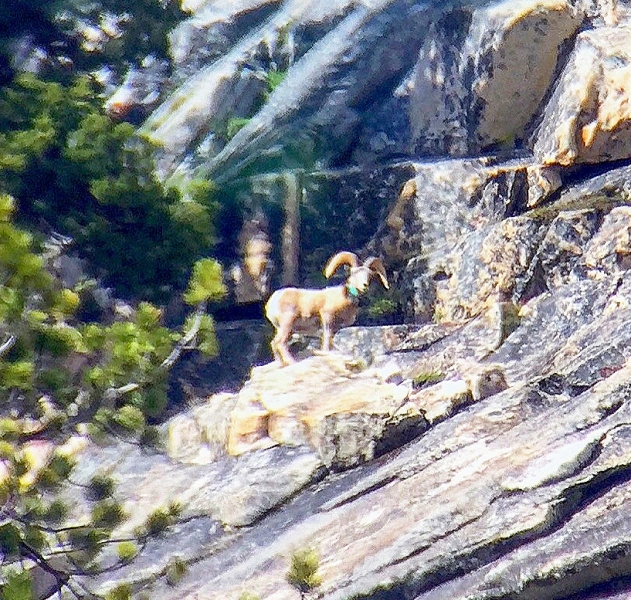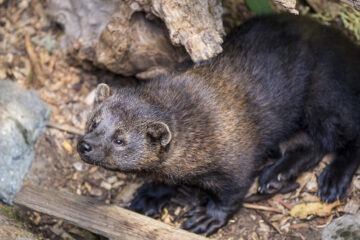It’s been a little over a year since biologists released Sierra Nevada bighorn sheep into Yosemite’s Cathedral Range, marking the return of the species to its historical habitat for the first time in more than 100 years.

Last March, through a multiagency operation supported by our donors, a herd of the endangered mammals was helicoptered in from other parts of the Sierra. A Yosemite Nature Notes video captured the momentous occasion, as biologists watched ewes emerge from the transport crates and spring off into the rocky cliffs of their ancestral home — the first bounding steps on a path toward establishing a self-sustaining population of bighorn in the heart of Yosemite’s Wilderness.

Over the past 15 months, experts from the National Park Service and the California Department of Fish and Wildlife have kept a close eye on the Cathedral Range herd. Last fall, they confirmed that two lambs had been born; surveys earlier this spring revealed that the herd and its pair of yearlings had survived the harsh high-elevation winter. Throughout 2016, scientists are continuing to monitor the herd using ground surveys and thousands of GPS data points.
Last year, our project coordinator, Ryan, headed into the field with a bighorn crew to search for signs of sheep near Yosemite’s eastern edge, where another herd had been reintroduced in the 1980s. They didn’t spot any sheep on that trip, but surveys throughout the year revealed that 85 bighorns were using the park.

Last weekend, Ryan trekked back into the mountains with Crystal Barnes, the park’s keen-eyed raptor surveyor, for another survey in bighorn territory. Armed with spotting scopes, telemetry receivers and a healthy dose of scientific curiosity, they set off to see if they could find the answers to a few important questions:
Q: Is there a new lamb in the Cathedral Range herd? Based on satellite telemetry data, it appears that one of the ewes came into contact with rams last fall.
A: TBD. Crystal and Ryan didn’t spot the ewe during their trip, but another crew from the California Department of Fish and Wildlife is conducting additional surveys in the area to search for the potential new mother.

Q: Are golden eagles nesting in the area? Golden eagles are known to prey on bighorn lambs. By studying which predators share the sheep’s habitat, scientists can better understand potential threats to the herd.
A: No. While no active golden eagle nests were found, there could be other predators in the area. Another survey team is heading out to search for carnivores, such as mountain lions, this summer.
Q: Are there any active peregrine nests around?
A: Yes! Upon checking a known peregrine nest site, they discovered that a pair of falcons had a new fledgling. Peregrines don’t prey on bighorns (they usually stick to birds and bats), but they are another example of a protected species making a comeback in Yosemite thanks to research and management projects supported by our donors.
Q: How much patience does it take to get a glimpse of a bighorn?
A: A lot. Here’s how Ryan describes the search:
We spent an entire day attempting to locate the three sheep that we knew were already in the area, using a combination of “glassing” (scanning with binoculars or telescopes) and telemetry. It was almost 5:30 pm before we got a really strong signal from the 10-year-old ram.

“So, have you ever seen a bighorn?” Crystal asked.
“Nope,” I replied, “not even on the herd count last year.”
“Well then, we’ve definitely got to spot this one. Come on out, sheepie!”
Five minutes later, she yelled, “Yes! I see him!” Her persistence and years of peregrine spotting paid off, and were key to locating the tiny sheep-shaped speck on the enormous cliff. For 15 incredible minutes, we watched the ram pose on the rocks near an ancient juniper, before he jumped down into the gully to feed on alpine plants. What a day!

Fifteen minutes might not sound like much. But when you remember that just over a year ago, and for a century before that, these majestic mammals were absent from this rugged range, that quarter-hour becomes a precious window into the remarkable story of a species returning from near-extinction.
Field surveys such as this one will continue through the fall, as scientists monitor Yosemite’s bighorns and support the recovery of an iconic Sierra species. To get a sense of what they’ll be seeing, check out the park’s new interactive bighorn map.
Thank you to our donors for generously supporting efforts to restore Yosemite’s bighorn sheep population for more than 30 years, and for funding many other grants to study and protect the park’s diverse wildlife!



